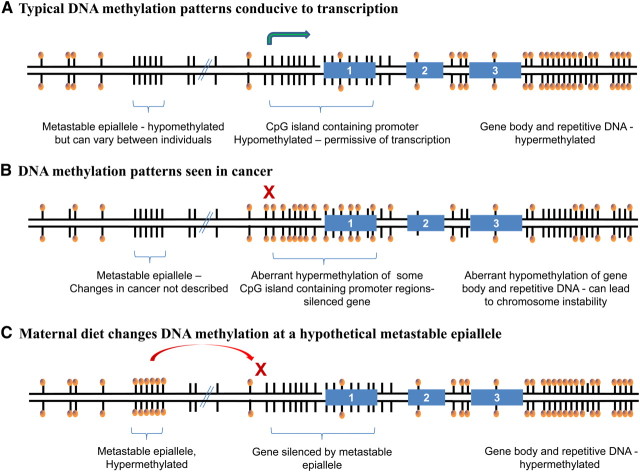Figure 2.
DNA methylation patterns at different types of genetic loci and how the patterns change in cancer and in response to maternal diet. This is a cartoon of a hypothetical single section of double-stranded DNA. Each bar represents a 5′-CpG -3′ site. Methylated CpG are indicated by bars with balls at the end. The green arrow indicates transcription start and active transcription. The red X equals gene silencing. The numbered blue rectangles are exons. (A) DNA methylation patterns conducive to transcription:– patterns set during development. CpGs throughout the genome are targeted for methylation by DNA methyltransferases (DNMT1, DNMT3a, DNMT3b). CpG islands are regions with a concentration of CpGs often (but not always) associated with the promoter regions of genes. CpG islands generally are thought to be actively protected from DNA methylation to allow for appropriate regulation of transcription (179). (B) Dysregulation of DNA methylation seen in cancer post-transformation. Cancer cells have aberrant DNA methylation patterns. Overall DNA methylation levels are reduced (58, 180–182). A subset of genetic sites is hypermethylated, including some tumor suppressor genes; the specific loci hypermethylated vary among types of tumors (114, 131). (C) Maternal diet changes methylation levels at the metastable epiallele, which can change transcription of a neighboring region. Metastable epialleles are regions of the genome that have a variable methylation patterns that are semiheritable across generations, illustrated by the agouti mouse model (147). In mice, a maternal diet that includes additional methyl donors can lead to increased methylation at the metastable epiallele (the intracisternal A particle retrotransposon), a change in expression at nearby genetic loci, and permanent changes in the phenotype distribution of the offspring (147). The sequence of the retrotransposon is a candidate for methylation in the early embryo; however, the extent to which it becomes methylated varies in genetically identical individuals based on maternal diet (methyl donors as well as other dietary factors) (146, 183). A recent study found candidate loci in the human genome that show differential methylation dependent on season of birth (148).

